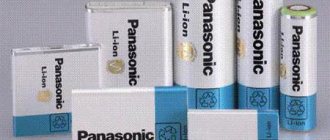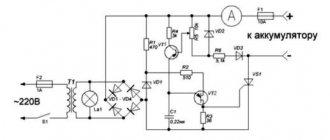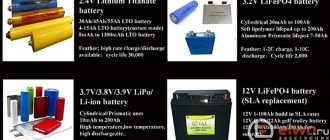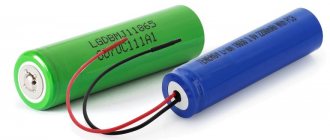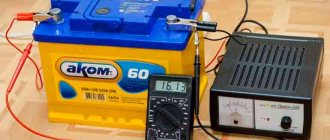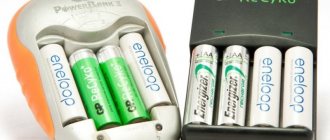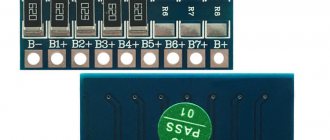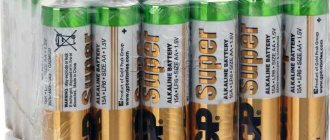Features of lithium polymer (Li-pol) batteries
Lithium is the lightest of the metals and has the highest electrochemical potential, providing high energy density. During operation, such a battery uses lithium metal electrodes.
Both polymer and ion batteries are significantly more efficient than their predecessors - nickel-cadmium and nickel-metal hydride batteries. Modern batteries have a much higher capacity, more charge/discharge cycles, no “memory effect”, and are more compact in size.
In terms of compactness, polymer batteries (Li-pol) occupy first place. These batteries use a polymer - a thin and flexible plate impregnated with electrolytes. Due to its compactness, the battery is only 1 mm thick. Such compact batteries allow designers to design smaller, lighter smartphones.
Main advantages of Li-pol batteries:
- The flexible polymer will make it possible to achieve smaller battery sizes, resulting in compact devices. In this parameter, polymer batteries are preferable to ion batteries, since the latter have reached the limit of thickness reduction.
- This battery is considered the most advanced, and therefore provides a greater level of safety, reducing the risk of overcharging and leakage of electrolytes.
- Polymer batteries have a longer service life, slower aging and self-discharge.
- Polymer batteries have a higher cost of materials for manufacturing (compared to ion batteries). Ultimately, this affects the price of the phone.
- High sensitivity to low temperatures.
- They heat up more.
Li-polymer battery: what is it
The lightest metal, lithium, has the greatest ability to donate electrons and is characterized by a significant energy density. These properties prompted the creation of batteries with lithium metal electrodes. But such batteries quickly failed and were unsafe to use.
The best results were achieved by battery developers who proposed replacing metal lithium with Li ions. This made it possible to increase the electrolyte density and battery capacity. Upgraded power supplies are designed for use at higher voltages and feature minimal self-discharge. Lithium-ion batteries are easy to maintain due to the absence of memory effect. This means that there is no need to strictly regulate the charging mode in order to avoid reversible loss of power supply capacity.
However, lithium-ion batteries have a number of disadvantages, the main one being their low level of safety. When developing a new type of lithium-based battery, the conventional liquid electrolyte was replaced by a 1 mm thick polymer film impregnated with a gel-like lithium-conducting electrolyte. The film element does not interfere with the exchange of charged particles, and does not conduct electric current. This made it possible to get rid of the separator (the porous partition between the electrodes), due to which the dimensions and weight of the battery were significantly reduced.
Due to the use of a gel-like electrolyte, safety is increased - Li-pol batteries do not ignite. The use of film elements has also made it possible to create lightweight and compact batteries of various shapes and sizes. This was primarily appreciated by manufacturers of portable equipment and electronics.
However, lithium polymer batteries have low electrical conductivity. It can be increased by heating, but overheating of the battery is dangerous, so in such cases a cooling system must be present. Another disadvantage of li-pol batteries is their high level of resistance. This makes it difficult to obtain the required current.
How to properly charge a lithium polymer battery?
Whatever battery is installed in a smartphone, without proper care it will quickly begin to wear out and lose capacity. Protect your phone from overheating and hypothermia. High temperatures can cause fire. As for low temperatures, in cold weather the battery's current output decreases due to a slowdown in the chemical reactions of the electrolytes. This is why mobile devices often turn off in extreme cold - a kind of self-defense.
To extend the life of your lithium polymer battery, charge it correctly and follow basic tips and tricks. Remember that many batteries are sensitive to temperature changes and complete discharges.
Modern batteries have a special controller installed that protects the smartphone from overcharging and overdischarging. It prevents the device from continuing to power the device after reaching 100% of the restored capacity, even if the charger cable is connected to the network. When the phone is completely turned off due to battery depletion, there is always some power left in the battery, since the controller turns off the device in advance. However, the phone needs to be charged as soon as possible after this.
Ideally, the device should not be allowed to completely discharge. Some experts recommend not charging the gadget above 90% and not discharging below 10% - this can extend the battery life. The exception is preventative calibration once every six months. To do this, you need to completely discharge your smartphone and then charge the battery to 100%.
When buying a new smartphone, it is important to follow simple rules for the first charge.
Operating rules
And now a little about the rules for using lithium-polymer batteries. There are not many of them, but it is worth following them - this will extend the life of the battery, which, by the way, is not cheap.
We do not allow deep discharge. Don't wait until your smartphone turns off due to low battery. We received a message about a low charge level - we connected the charger. Better yet, we recharge the gadget at any opportunity, regardless of the state of the battery.
In the event of an emergency shutdown, we charge immediately . If a smartphone turns off unexpectedly, this does not mean that it is consuming energy. It does consume, albeit quite a bit. But if we throw it on the table for a week, we will bring the battery to a critical discharge.
We do not charge at subzero temperatures. Although lithium batteries can operate at negative temperatures, they cannot be charged at this temperature. This will significantly reduce the battery life, and it will still not be possible to charge it properly.
We use only high-quality memory . You should not use Noname chargers purchased on the market for pennies to charge your gadget. Even if their output voltage is normal now, it can “jump” at any moment. The best option is a standard charger.
We don't listen to stupid advice. Very often you can hear the opinion that Li-ion batteries need to be charged to 60% and discharged to 40%. This is inconvenient, but it will do no good and will not prolong the life of the current source.
We do not freeze the gadget. Lithium cells can work at minus temperatures, but they do not feel well in the cold. No need to spend hours chatting at -15. They took out the phone, called and put it in a warm pocket.
Could it explode or catch fire?
One of the features of lithium polymer cells, as noted above, is their safety. In principle, if such a battery is damaged, if it is properly charged, it can catch fire. But usually replaceable batteries are made in a fairly rigid aluminum case. In order to damage them, you have to try. For example, deliberately hitting someone with something heavy or piercing them. Elements in a soft case are easier to damage, but, as a rule, the average consumer does not have access to them - they are replaced at service centers.
Short circuits that can cause a fire due to the design features of the battery if used incorrectly are also extremely rare. They are usually caused by excess pressure, but since the body is soft, it “shocks”—inflates. Moreover, the soft polymer case is able to increase its volume three or more times.
In any case, rupture of the soft case usually occurs before the pressure reaches a value capable of causing a short circuit. And it’s very difficult to push through the polymer separator, unlike the porous one in Li-ion.
However, there are still isolated cases of fire, but they are extremely rare. This usually happens when trying to charge an already swollen battery or due to severely exceeding its service life. Therefore, if the battery is old and has served its purpose, it is better to replace it rather than “squeeze” the last percent out of it. Not only can this cause problems, but it is also simply inconvenient.
Important! Of course, increasing in volume, a polymer battery can damage the gadget - tear off the cover, crush the display, etc., but, in any case, it will not start a fire or injure a person.
As for the explosion, yes, the battery can rupture when swelling, but it will not be the explosion of a fragmentation grenade, but rather a harmless bang. The latter, however, can also damage the phone, but it will not harm people.
Results
Lithium-polymer batteries in the world of mobile devices are currently considered the most modern and relevant due to a number of positive qualities and compact size. Remember that you need to take care of your phone battery - this way it will last much longer.
A modern mobile device, in addition to its original purpose – a means of communication – performs many other functions. This includes access to the Internet, a photo and video camera, the ability to watch movies, listen to music and play games, and much more. Therefore, the batteries of such devices have to be charged frequently. How to do this correctly to extend the life of the battery and increase its resource?
Types of telephone batteries
Modern smartphones use lithium-ion (li-ion) and lithium polymer (li-pol) batteries. Lithium-ion replaced their predecessors - nickel-cadmium and nickel-metal hydride - and surpassed them in many respects. However, during operation, their shortcomings were also revealed. Lithium electrodes turned out to be unstable. Therefore, this material was no longer used in its pure form, replaced by various compounds. The resulting batteries met all the requirements, and therefore firmly occupied their niche.
Modern smartphones also use lithium polymer batteries. It uses the principle of the transition of polymers to a semiconductor. Electrolyte ions are introduced into polymers, this improves conductivity.
Today the following types of batteries are produced:
- polymer electrolytes with lithium salts embedded in them;
- dry polymer-based electrolytes;
- microporous matrices into which non-aqueous solutions of lithium salts are embedded.
Developments in this direction are ongoing to this day, so the technology continues to improve.
Older phones usually use nickel-cadmium and nickel-metal hydride.
Memory effect, battery aging, calibration
In general, a lithium-ion battery does not have a memory effect. No special “training” or “calibration” of the new device is required.
How to measure battery capacity
It is quite natural that during operation the capacity decreases and ceases to correspond to the values indicated on the case. But if there is a need to find out the real capacity of the battery, it is quite possible to do this. There are two options on how to do this.
One of them is to use a special device called “Aimak”. This device includes a tester, voltmeter, ammeter and more. Its only drawback is its expensive cost. Therefore, it will be much easier for most users to use a USB tester. In terms of pricing, it is much more acceptable, and the measurement accuracy is at a very decent level.
To find out the actual capacity of the batteries, you first need to fully charge it, and then discharge it through one or another load, connecting a tester between the element and the load. The input of the device must be connected to the battery, and the output to the load. You can use a half-watt resistor with a resistance of 8-16 Ohms as it.
How to properly charge a new smartphone battery
Many people have heard that a new battery needs to be charged in a special way, otherwise it will fail faster. But if the battery is non-removable, then replacing it will not be easy at all.
It is recommended to “boost” a brand new battery. Here's what you need for this:
- Completely discharge the battery to zero. There is no need to do this on purpose, torturing the smartphone in every way - let the discharge occur gradually, during normal use. The main thing is that it is complete.
- Then put the device on charge. You need to look in the manual for it to see how long a full charge and discharge cycle takes, and add a couple of hours to the battery recovery time.
- After fully charging, use the phone as usual, but again wait until it is completely discharged and repeat the procedure. And so - 3-4 times. This increases the battery life and allows it to last longer.
Important! Such a “buildup” is acceptable only for new smartphones; if the device has been in use for a long time, then the reception can, on the contrary, be harmful.
How to properly charge a new phone with a li-ion battery
There are some nuances here. Lithium-ion batteries do not handle full discharge and charge very well. Therefore, even at the very beginning of operation, you should not abuse the “swing”, limiting yourself to 2-3 times. In the future, the battery charge should be kept within 20-80%; you should not allow it to completely discharge, nor should you keep it plugged in all the time. It would be optimal to not allow the battery to charge completely, leaving the charge at 90-95%.
How to properly charge a new smartphone with a li-pol battery
Li-polymer batteries do not like deep discharge at all. Manufacturers recommend charging the battery completely the first few times, but in this case it is better not to let it drop to zero. At an indicator of 10-15 percent, it is worth connecting the device to the mains. In the future, it is recommended to recharge it at every convenient opportunity - in small portions.
There are different opinions on whether a new phone should be completely discharged and charged. On the one hand, li-ion and li-pol do not have a memory effect, so this makes no sense. On the other hand, during production, an inhibitor is added to the battery, which should extend the life of the battery, and it is during the first charging and discharging that it is destroyed, which allows for maximum life expectancy and capacity to be achieved.
Application
The areas of application of batteries with li pol electrolytes are determined by the main tasks assigned to them, as well as external conditions.
Main Use
These power sources significantly increase the operating time of many stationary devices, despite the fact that they have a relatively small mass; this is the difference between ion batteries and lithium polymer batteries. Ordinary li pol batteries are used to power devices such as tablets, phones and other types of various gadgets and toys. Fast-discharge ones are used to ensure stationary operation of devices with increased current consumption.
The increased discharge current is used in remote control devices such as toy helicopters and airplanes, as well as in the operation of handheld tools and hybrid vehicles.
Restriction on use
The widespread use of polymer batteries has some limitations:
- Special conditions for replenishing charge. These batteries are classified as fire hazardous during charging, so manufacturers recommend using only special devices with control and protection systems for overheating.
- Do not expose to microwaves or high pressure.
- Do not connect to devices directly after charging; you must wait until the internal temperature of the battery drops to the operating value.
How to extend your phone battery life
Different batteries require different approaches, but there are general rules that should be followed for all types of batteries to extend their service life:
- You should only use the “native” charger - when it reaches full charge, it stops supplying power to it, even if you do not disconnect it from the network. Therefore, recharging will not occur in any case. Using someone else's charger can damage the battery's performance. “Native” chargers also meet all the requirements for this particular model: voltage, output current, power.
- It is necessary to maintain the optimal temperature both during operation and during storage of the smartphone. This is room temperature. Both overheating and hypothermia, as well as sudden temperature changes, are equally harmful to the device.
- If no one will use the mobile device for a long time, then you should not fully charge it before doing so, nor should you discharge it to zero. This will damage the battery. It is optimal to turn off and put away the phone when the charge level is about 50%.
Next are the nuances of operating different types of batteries.
How to properly charge a smartphone with a li-ion battery
Lithium-ion batteries do not like to be completely discharged (except for calibration) and recharged. It is optimal to maintain the charge level between 20 and 90%.
You can charge in different ways:
- Standard charger. Its characteristics are optimal, so it is advisable to use it. Only if this is not possible, resort to other methods.
- While working at the computer, you can also connect your mobile device to it and charge it. However, this will take much longer than charging through a wall outlet.
- Cigarette lighter in a car. Convenient for those who drive, but the process may also not be quick, depending on the device parameters.
- Universal memory. Such a device is popularly called a “frog”. Suitable for different types of batteries.
Charge calibration is recommended every three months. It involves a complete discharge followed by a full charge.
How to properly charge a phone with a li-pol battery
Lithium-polymer batteries do not like overdischarge and 100% charge. It is better to keep it in the range from 20 to 90%, and when this indicator is reached, disconnect from the network. If, while discharging, you still miss the moment and the device turns off, you do not need to keep it in this state, but should immediately put it on charge.
With lithium-polymer batteries, you should not be afraid of recharging too often - on the contrary, this should be done in small portions whenever possible. The main thing is not to keep it on charge for several hours and not reach 100% of the scale.
It is harmful for such a battery to be constantly connected to the electrical network. The controller built into the charger will disconnect it from charging at the right moment, but heat will continue to flow. This harms the lithium polymer battery.
All batteries have a built-in controller that controls the charging and discharging process. That is, when the battery is discharged to zero, there is still some amount of charge left, and when it reaches 100%, the controller stops sending current into the battery; as soon as the charge level drops to 99%, the voltage will flow again.
How to properly charge a phone with a ni-mh battery
Nickel-metal hydride (ni-MH) batteries are less durable than modern ion batteries. They also have a memory effect. That is, the battery “remembers” what state its charge reached before and begins to discharge faster.
To prevent this from happening, such batteries need to be “trained”: periodically completely discharged and then fully charged. This allows you to increase capacity by an average of 5%.
What is multi-stage charging?
This method consists of three stages. Immediately after connecting the charger, the controller measures the voltage on the battery. When readings are below 2.5 V, charging is carried out with a small (about 0.02-0.1 C) current until the voltage rises to 2.8 V. If it is initially higher, this stage is simply skipped.
Next, the charging current increases to a value of 0.5 C (normal charge) or 1 C (accelerated charge). And this stage ends when the voltage on the element rises to 4.1-4.2 V
When a stable voltage of 4.14-4.25 V is established on the element, it is recharged with a small current. And the stage ends as soon as the current value decreases to 0.05 C.
It is important to know that the third stage takes quite a lot of time. But it is not mandatory. If there is no opportunity or desire to wait, you can limit yourself to the second stage. Because during this period the battery reaches almost its entire capacity (90-95%)
What is not allowed when charging a phone battery
All batteries, without exception, do not tolerate:
- hypothermia;
- overheating;
- blows and other physical damage;
- sudden change in temperature;
- use of non-native memory;
- permanent connection to the power grid.
Depending on the type, they also have some other “predilections”.
With li-ion battery
The following should not be allowed with this type of battery:
- frequent complete discharge;
- constant 100% charge;
- storage in a discharged state;
- too frequent charge calibration;
- overheating and hypothermia.
It’s better to keep the battery charge up to 90%, and do a “training session” every few months, and everything will be fine.
With li-pol battery
The following should not be allowed with this type of battery:
- full discharge;
- training or calibration;
- full charge;
- permanent connection to the power grid;
- overheating and hypothermia.
Just like with li-on, the optimal charge will be in the range from 20 to 90%.
With ni-mh battery
The following should not be allowed with this type of battery:
- recharge;
- frequent charge “little by little”;
- storage fully charged or completely discharged;
- overheat.
In order not to lose the capacity of such a phone, it is recommended to charge it completely and discharge it as much as possible. “Train” periodically.
Features of Li-pol batteries
Lithium is the lightest metal with high electrochemical potential and energy density.
Batteries based on it are superior in efficiency to their predecessors containing nickel and cadmium. With a high capacity and a higher number of charging cycles, they are much more compact in size.
The smallest among lithium batteries are polymer Li-pol type, created on the basis of a thin plate impregnated with electrolytes. The 1 mm thickness of the power supply allows for the creation of lightweight and thin devices with long battery life.
The peculiarity of lithium-polymer batteries is their long service life and slow process of failure and self-discharge.
Without proper care, the battery quickly loses capacity and fails. The basic rule for using lithium polymer batteries is protection from temperature extremes. Strong heating can cause a fire, and when overcooled, the polymer energy source simply stops functioning as the chemical reactions of the electrolytes slow down.
Lithium polymer batteries are sensitive to discharge, so it is important to monitor the battery's charge level. The latest models of smartphones and tablets have a controller installed that protects the device from overcharging and completely discharging.
The operating principle is based on maintaining the energy balance inside the battery. When fully charged, the controller stops feeding the gadget, even if the charging cable is connected to the device.
When the smartphone's battery is discharged, the controller turns it off in advance so that a little power remains, which maintains the operating condition of the battery, but does not allow the use of the device.
However, once every six months it is useful to do a calibration - discharge the battery until the device turns off, then charge it to 100%.
Where are they used?
Li-polymer batteries are incredibly popular in the modern world. They are most often used as power supplies for electronic devices that consume relatively little current. Therefore, it is not surprising that the vast majority of smartphones are based on lithium-polymer batteries. At the same time, the devices on which manufacturers are trying to save money have less advanced lithium-ion batteries on board.
The smartphone is not the only type of device that uses LIP batteries. Similar batteries are also built into other gadgets:
- tablets;
- laptops;
- wireless speakers and headphones;
- smart watch;
- toys.
This list of devices can be continued almost indefinitely. But the main thing that the user must understand is that lithium-polymer power supplies are not suitable for large-sized devices that require high current. That is why the main gadget where such batteries are used are smartphones.
How to properly charge a lithium polymer battery
The operation of a lipo battery includes a number of rules, compliance with which will help keep it in working condition and ensure a long life cycle of the device.
The following recommendations must be followed:
- Do not allow the gadget to turn off. As mentioned above, you need to charge the device immediately after a signal about a low battery charge; each shutdown when completely discharged reduces the performance of the battery and reduces its capacity.
- Recharge. If you have a power outlet, a car cigarette lighter or a PC at hand, it’s worth recharging your smartphone, even when the percentage is still high. The main thing is not to allow a full charge with such short recharges.
- Maintain an optimal charge level. The ideal level of charge for a lithium-polymer battery is 50%; of course, achieving a constant figure in the modern rhythm of life is difficult. However, it is realistic to provide a range of 30-80%, this will keep the battery in good condition and protect it from wear.
- Disconnect power from the network in a timely manner. With prolonged contact with current, the battery will be protected by the controller from overcharging, but not from overheating, since chemical reactions inside the battery continue. Such overpowering dramatically shortens the battery life and in some cases leads to an explosion.
- Use an original charger. Any gadget, be it a smartphone or a laptop, comes with a power supply and charging cable. It is the original charger that is calibrated for the characteristics of a specific model and allows for proper charging of the battery. If the charging kit fails, you should purchase a charger certified by the manufacturer.
- Store the device with an average charge percentage. If a smartphone or other gadget will not be used for a long time, you should store it turned off, after charging the battery to 50–60%. The peculiarity of lipo batteries is that they work in an inactive state, so it is not surprising that after switching on the charge will be lower than when switched off.
- Avoid charging when the battery is hot. Active use of the device can lead to heating of the battery; if the cover of the device becomes hot and the smartphone or tablet is uncomfortable to hold in your hands, charging it is strictly prohibited. The already high temperature upon contact with current will only increase, which will lead to fire or explosion of the device.
- Limit operation while charging. The ideal state for charging a smartphone or other gadget is the off state. At the same time, the battery is safely recharged, heating up minimally. Of course, turning off the device for several hours is not always possible. In this case, it is necessary to optimize the work as much as possible - turn off the connection to the Internet, the GPS and Bluetooth module, limit the use of the smartphone for calls, SMS or other purposes.
Advice from the Screwdriver channel’s specialists will help you use your smartphone’s lithium-polymer battery correctly; in the video, they will tell you the secrets of the battery’s durability and high capacity.
How to charge a lithium-polymer smartphone battery 1 time after purchase
The gadget out of the box usually shows a charge level of 30–40%. This is the result of battery conservation at the production stage: a special composition inhibits the action of electrolytes. This method preserves the battery capacity and its properties on the way to the buyer.
The preservative composition must be deactivated immediately after purchase by defrosting the battery and preparing it for use; this procedure is called pumping. To carry it out, you need to discharge your smartphone to a level of 10–15%, then connect the device to the network until it is fully charged. Repeat the cycle 2-3 times, then use short recharges, avoiding extreme conditions.
So, in order to extend the life of a lithium-polymer battery and use a mobile device for a long time, you need to protect it from exposure to high and low temperatures, reduce its contact with metal objects, and avoid shocks and damage to the battery.
Main characteristics
Solid electrolyte batteries have replaced alkaline batteries, replacing them in many types of electronics. Long service life, low self-discharge currents, as well as increased safety of use have significantly expanded the use of such power supplies.
The main characteristics of lithium polymer batteries include
- ability to charge and discharge up to 1000 times;
- monthly lose up to 5% of charge on their own;
- reduced weight due to the possibility of using new technologies for replacing metal parts in the battery;
- energy density reaches values up to 200 Wh/kg;
- operating temperature range from -20°С to +60°С;
- operating voltage value up to 3.7 V;
- thickness of polymer batteries from 1 mm;
- discharge voltage from 3 V;
- the maximum current value exceeds its own capacity twice;
- natural aging by 20% in 3 years.
There are fast-discharging batteries, they are 20% heavier than standard models and have a discharge current that is 8 times higher than their own capacity value.
It is important to know! Many types of electronics cannot withstand increased discharge currents.
